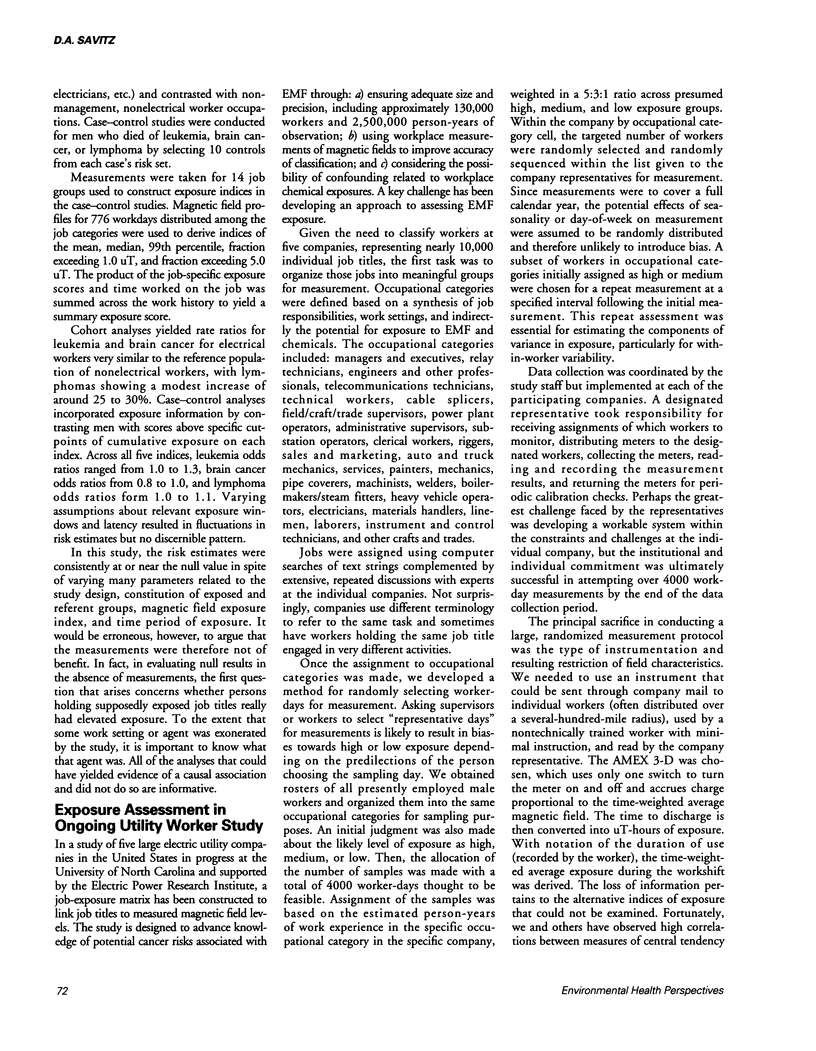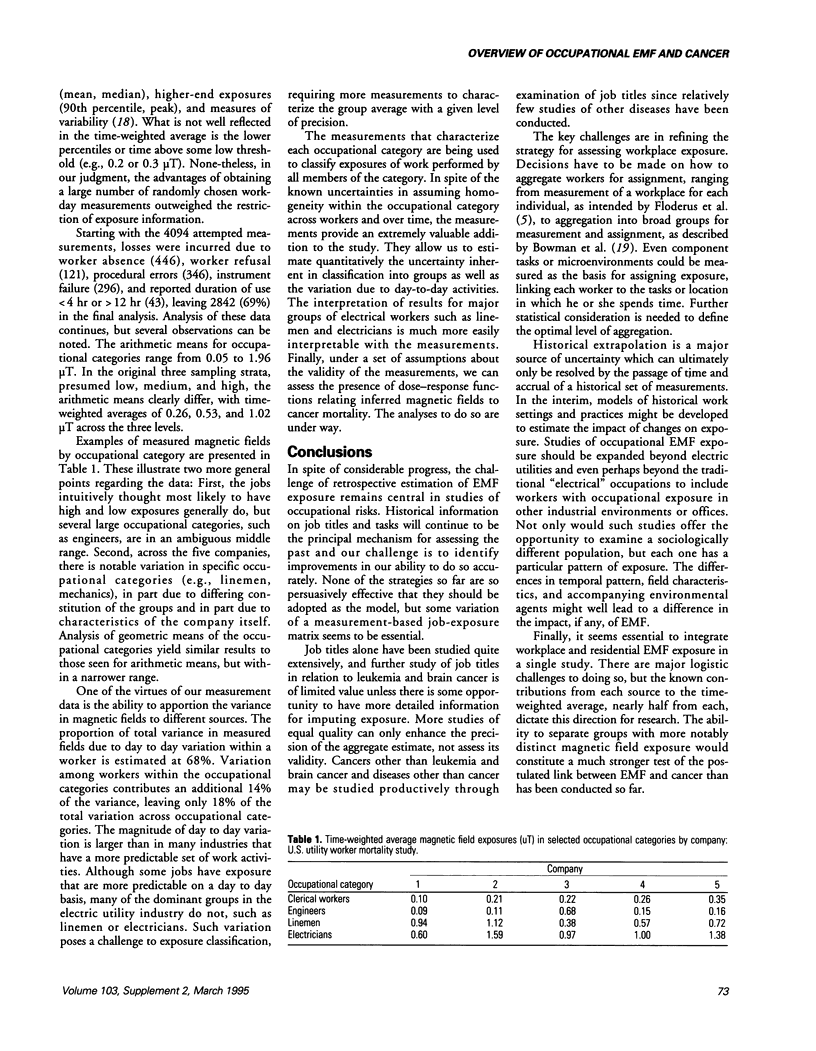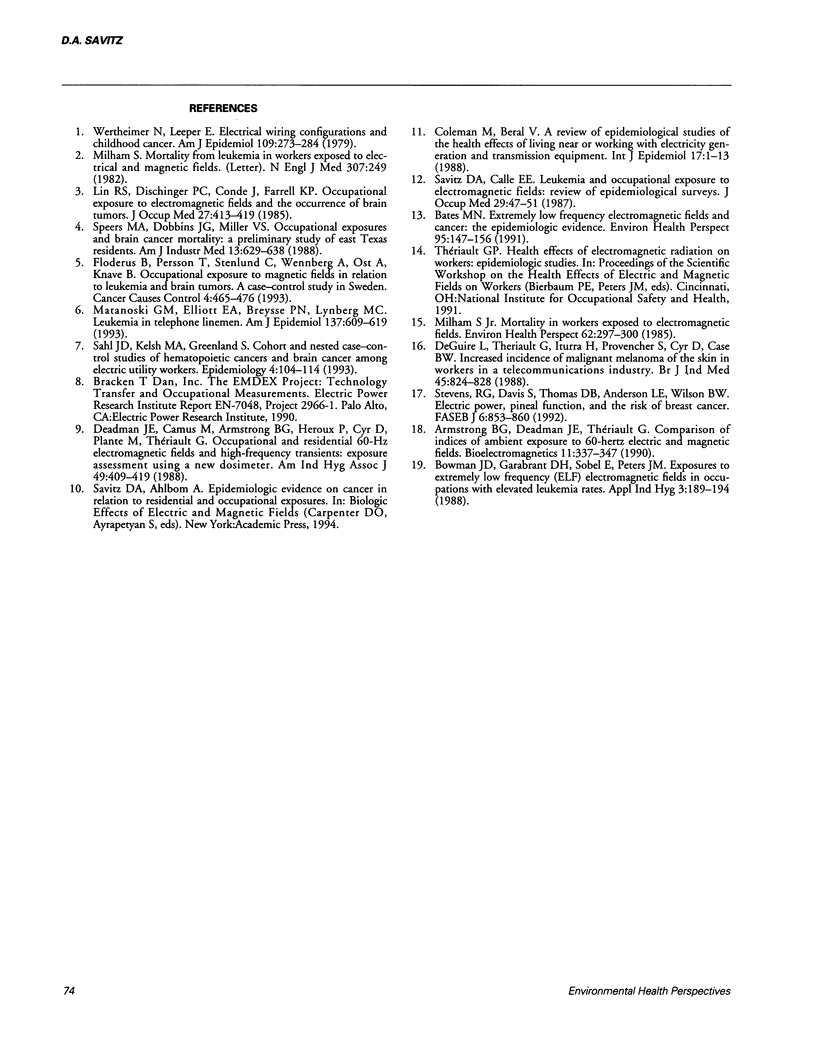Abstract
For over ten years, there has been concern with the potential for increased risk of cancer among "electrical workers." In contrast to studies of residential exposure to magnetic fields, occupational studies include electric and magnetic field exposures and have much greater variability in field intensity, frequency, and temporal patterns. Studies of leukemia in electrical workers show a moderate consistency, with elevated risk ratios of 1.2 to 2.0 commonly observed. Brain tumors are similarly elevated with some consistency, and three recent studies have suggested increased risk of male breast cancer. Retrospective exposure assessment methods were advanced in recent studies of diverse occupations in a study in central Sweden, which yielded evidence of increased risk of chronic lymphocytic leukemia among men in more highly exposed occupations. A study of telephone workers in New York State incorporated measurements and found some indication of increased leukemia risk only when exposures were based on historical technology. Utility workers in southern California were studied and found not to have increased risks of leukemia and brain cancer based on exposures estimated with measurements. An ongoing study of electric utility workers at five companies in the United States incorporates an extensive measurement protocol. Randomly selected workers within occupational categories wore a time-integrating magnetic-field meter to provide estimates of exposure for the occupational category. We were able to estimate and partition the variance into between-day (the largest contributor), within occupational categories, and between occupational categories. Principal research needs concern optimal levels of worker aggregation for exposure assignment, historical extrapolation, study of diverse work environments, and integration of residential and occupational exposure in the same study.
Full text
PDF





Selected References
These references are in PubMed. This may not be the complete list of references from this article.
- Armstrong B. G., Deadman J. E., Thériault G. Comparison of indices of ambient exposure to 60-hertz electric and magnetic fields. Bioelectromagnetics. 1990;11(4):337–347. doi: 10.1002/bem.2250110408. [DOI] [PubMed] [Google Scholar]
- Bates M. N. Extremely low frequency electromagnetic fields and cancer: the epidemiologic evidence. Environ Health Perspect. 1991 Nov;95:147–156. doi: 10.1289/ehp.9195147. [DOI] [PMC free article] [PubMed] [Google Scholar]
- Coleman M., Beral V. A review of epidemiological studies of the health effects of living near or working with electricity generation and transmission equipment. Int J Epidemiol. 1988 Mar;17(1):1–13. doi: 10.1093/ije/17.1.1. [DOI] [PubMed] [Google Scholar]
- De Guire L., Theriault G., Iturra H., Provencher S., Cyr D., Case B. W. Increased incidence of malignant melanoma of the skin in workers in a telecommunications industry. Br J Ind Med. 1988 Dec;45(12):824–828. doi: 10.1136/oem.45.12.824. [DOI] [PMC free article] [PubMed] [Google Scholar]
- Deadman J. E., Camus M., Armstrong B. G., Héroux P., Cyr D., Plante M., Thériault G. Occupational and residential 60-Hz electromagnetic fields and high-frequency electric transients: exposure assessment using a new dosimeter. Am Ind Hyg Assoc J. 1988 Aug;49(8):409–419. doi: 10.1080/15298668891379981. [DOI] [PubMed] [Google Scholar]
- Floderus B., Persson T., Stenlund C., Wennberg A., Ost A., Knave B. Occupational exposure to electromagnetic fields in relation to leukemia and brain tumors: a case-control study in Sweden. Cancer Causes Control. 1993 Sep;4(5):465–476. doi: 10.1007/BF00050866. [DOI] [PubMed] [Google Scholar]
- Lin R. S., Dischinger P. C., Conde J., Farrell K. P. Occupational exposure to electromagnetic fields and the occurrence of brain tumors. An analysis of possible associations. J Occup Med. 1985 Jun;27(6):413–419. [PubMed] [Google Scholar]
- Matanoski G. M., Elliott E. A., Breysse P. N., Lynberg M. C. Leukemia in telephone linemen. Am J Epidemiol. 1993 Mar 15;137(6):609–619. doi: 10.1093/oxfordjournals.aje.a116718. [DOI] [PubMed] [Google Scholar]
- Milham S., Jr Mortality from leukemia in workers exposed to electrical and magnetic fields. N Engl J Med. 1982 Jul 22;307(4):249–249. doi: 10.1056/nejm198207223070412. [DOI] [PubMed] [Google Scholar]
- Milham S., Jr Mortality in workers exposed to electromagnetic fields. Environ Health Perspect. 1985 Oct;62:297–300. doi: 10.1289/ehp.8562297. [DOI] [PMC free article] [PubMed] [Google Scholar]
- Sahl J. D., Kelsh M. A., Greenland S. Cohort and nested case-control studies of hematopoietic cancers and brain cancer among electric utility workers. Epidemiology. 1993 Mar;4(2):104–114. doi: 10.1097/00001648-199303000-00005. [DOI] [PubMed] [Google Scholar]
- Savitz D. A., Calle E. E. Leukemia and occupational exposure to electromagnetic fields: review of epidemiologic surveys. J Occup Med. 1987 Jan;29(1):47–51. [PubMed] [Google Scholar]
- Speers M. A., Dobbins J. G., Miller V. S. Occupational exposures and brain cancer mortality: a preliminary study of east Texas residents. Am J Ind Med. 1988;13(6):629–638. doi: 10.1002/ajim.4700130603. [DOI] [PubMed] [Google Scholar]
- Stevens R. G., Davis S., Thomas D. B., Anderson L. E., Wilson B. W. Electric power, pineal function, and the risk of breast cancer. FASEB J. 1992 Feb 1;6(3):853–860. doi: 10.1096/fasebj.6.3.1740235. [DOI] [PubMed] [Google Scholar]
- Wertheimer N., Leeper E. Electrical wiring configurations and childhood cancer. Am J Epidemiol. 1979 Mar;109(3):273–284. doi: 10.1093/oxfordjournals.aje.a112681. [DOI] [PubMed] [Google Scholar]


